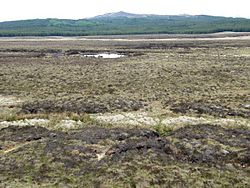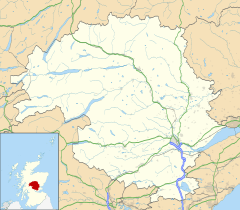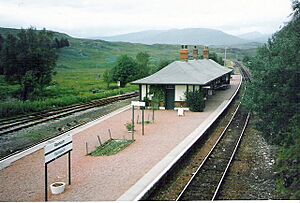The Soldiers' Trenches, Moor of Rannoch facts for kids
Quick facts for kids The Soldiers' Trenches
|
|
|---|---|
 The Soldiers' Trenches |
|
| OS grid reference | NN 42178 52198 |
| Council area | |
| Country | Scotland |
| Sovereign state | United Kingdom |
| Police | Tayside |
| Fire | Tayside |
| Ambulance | Scottish |
| EU Parliament | Scotland |
The Soldiers' Trenches are long ditches found on Rannoch Moor in Scotland. British army soldiers dug these trenches between 1763 and 1764. Their main goal was to drain parts of the wet moorland. They hoped to turn this land into useful fields for growing crops or for animals to graze.
The Story of the Trenches
These trenches are located near the West Highland Line. There are five large ditches that run side-by-side. Soldiers from the British army dug them between 1763 and 1764.
The project was led by a man named James Small. He was an Ensign, which is a junior officer in the army. Small was also the "Government Factor" for the area. This meant he managed land that had been taken from people who supported the Jacobites. The Jacobites were people who wanted to bring back the old royal family to the throne.
James Small started his job in 1754 and stayed until he died in 1777. He worked hard to improve farming in the area. For example, he introduced the use of lime to make the soil less acidic.
Why Were They Dug?
Before the trenches, this land was used by local people in summer. They would take their animals to graze there. This practice was called "shieling."
The soldiers dug the trenches to "drain and sweeten the soil." They wanted to make the land good enough for farming. They hoped to grow crops and create new pastures for animals.
What Happened Next?
Even with all the hard work, the project did not succeed. The land was too wet and difficult to drain. So, the area went back to being moorland.
However, the trenches were dug so deeply that you can still see them today. They are now filled with Sphagnum moss. This is why they are called 'The Soldiers' Trenches'. The West Highland Line railway even cuts through some of them.



